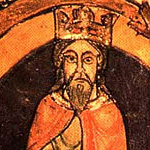Leges inter Brettos et Scottos facts for kids
The Laws of the Brets and Scots (known in Latin as Leges inter Brettos et Scottos) was a very old set of rules from Scotland. These laws were put together during the time of David I of Scotland, who ruled from 1124 to 1153. Only a small part of the original document still exists today. It mostly talks about the payments or punishments for harming people.
Back then, the term "Brets" usually meant people who spoke Brythonic languages, like old Welsh. "Scots" referred to people who spoke Goidelic languages, which is an old form of Gaelic. However, some historians believe that in these laws, "Scots" meant all the people living north of the Clyde and Forth rivers.
These laws are very important for understanding the history of Scotland. They are also interesting because they are quite similar to old Irish laws (called Brehon law) and Welsh law. These other law systems are much better preserved. By comparing them, we can guess a lot about the customs and rules in medieval southern Scotland, where not many records have survived.
Some parts of these old laws were even banned later on. For example, the "Laws of the Four Burghs" (a set of rules for four important towns) specifically outlawed parts of the "Laws of the Brets and Scots" that dealt with something called cro, which was a payment for someone's death.
The "Laws of the Brets and Scots" were officially cancelled in 1305 by Edward I of England, after he invaded Scotland. But even after that, they still seemed to influence Scottish law. For instance, a practice called 'Galanas' (which was a British or Welsh term for a payment) continued to be used until at least the late 1500s.
Imagine this: In 1587, after Mary Queen of Scots was executed, English and Scottish ambassadors met. The English said Queen Elizabeth was very sorry about Mary's death. They asked what kind of payment or satisfaction could be offered to James VI, Mary's son. The Scots replied that it wasn't up to James to decide. Instead, it was the "custom of Scotland" that those who caused a death should offer payment to the victim's family and friends. Then, the family would discuss and agree on the payment. This shows how deeply rooted the idea of compensation was in Scottish justice, even for a king!
Contents
What the Surviving Laws Tell Us
The parts of the laws that still exist show that society was based on families and relatives. If someone did something wrong, their family was often responsible. And if someone was harmed or died, the victim's family would receive a payment. Like other Celtic societies, women had specific rights and duties, though they were not always equal to men. Marriages were seen as connections between different families. Payments for harm could go to the victim's spouse's family in some cases, but to the victim's own family in others.
Types of Payments and Penalties
The laws described different kinds of payments for various harms.
Payments for Death
- Payments for death (called cro, enach, and galnes) were like a "weregild." This was a payment made to the victims or their families if someone was killed. It was a way to compensate for the loss of a family member.
Payments for Breaking the King's Peace
- Payments for breaking the king's peace were separate from other payments for causing a death. These payments were made if someone disturbed the peace of the king. There were also smaller payments for disturbing the peace of other important people, like nobles. The payment went to the person whose peace was broken.
Payments for Wounds or Insults
- Payments for wounding or insulting someone's honor (called kelchin or gelchach) were made to the victims or their families. The amount of payment depended on how serious the wound was. For example, there was a different payment for drawing blood than for a wound that didn't draw blood.
How Payments Were Decided
The amount of money or goods to be paid depended on the social standing of the person who was harmed.
- The king had the highest value, meaning the biggest payment.
- His son or a high-ranking noble had a slightly lesser value.
- Other nobles had an even lesser value.
- And so on, down to the lowest amount for a common person.
Payments for causing a death were given in cows or an equal amount of gold. Payments for wounds or insults were only given in gold.
Women's Rights in Payments
If a woman was the victim, her payment was one-third less than her husband's. However, if she was unmarried, her payment was equal to her brother's. These laws show that women kept their original family ties and rights even after marriage. For example, if a woman died, the death payments were owed by her own family, not her husband's. And if payments were made for her death, they went to her family, not her husband's. The importance of marriage was also recognized, as some payments for insults went to the victim's spouse, not just to the victim's family.
See also
- Anglo-Saxon law
- Davidian Revolution
- Brehon law
- Celtic law
- Welsh law


